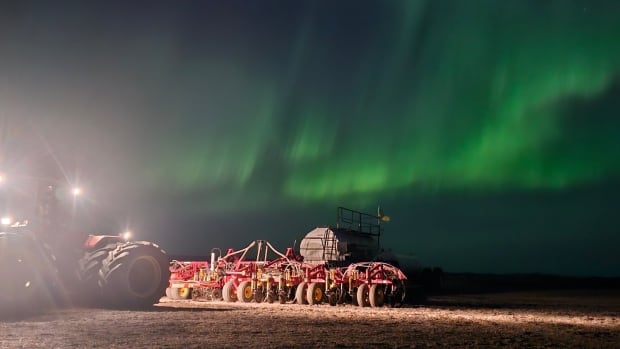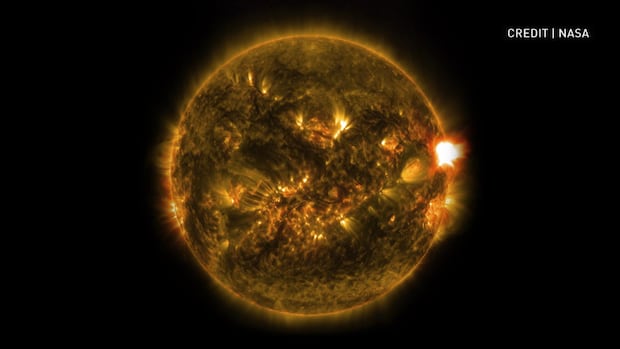
Tanner Borsa was working his farm near Yellow Creek, Sask., last weekend when the Global Positioning System in his tractors stopped working.
Like many farmers, Borsa pays for a premium GPS satellite signal to ensure accuracy and efficiency when he’s planting seeds and spraying pesticide and fertilizer. When that signal went out on Friday night, he called his provider.
“They basically told me that it’s a solar flare [and] there’s nothing they can do about it,” Borsa said. “They didn’t really have an estimate on how severe or how long lasting the impact would be.”
For Borsa, the problems continued off and on all weekend, in tandem with the powerful solar storms that brought dramatic views of the northern lights to much of Canada and the U.S.
He’s not alone. Farmers across Canada and in some parts of the U.S. experienced similar GPS blackouts and malfunctions on their equipment during the weekend.
With more solar storms on the horizon and an increasing reliance on GPS across different industries, experts say the problem isn’t going away any time soon.
Why and how farmers use GPS
GPS, or satellite-based navigation, has become standard in the agricultural sector.
Jordan Wallace, a farmer who runs the GPS retailer and distributor GPS Ontario out of North Gower, Ont., says he was fielding dozens of calls all last weekend from farmers from B.C. to P.E.I., as well as customers in Texas and Georgia.
“In agriculture right now, we’re at the height of the planting season,” he said. “And accuracy of signal is of extreme importance.”

Farmers use GPS on their tractors, sprayers and harvesters to ensure they evenly distribute seeds, pesticides and fertilizer without overlap. Some vehicles even drive themselves, following the lines the GPS mapped out.
“Your seed, your fertilizer, your pesticides, they cost quite a bit of money,” Borsa told CBC from his self-driving tractor. “And over-applying them or overlapping as you work your field is basically wasting money.”
Luke McCreary, a farmer near Bladworth, Sask., says his GPS equipment was off by nearly two metres during Friday night’s solar storms, forcing him to manually compensate.
“Anywhere that I’m driving manually instead of using the GPS, we’re missing out on the optimization … that we hope to get when we have systems like this installed on the tractor,” he said.
As It Happens5:58Nebraska farmer says solar storm cost him time and money
Craig Frenzen, a farmer in Fullerton, Neb., says rainfall in his region had already kept farmers from seeding during their already narrow planting window. When the solar storm knocked out the GPS on one of his tractors, it put him even further behind.
“When we do get the right conditions to plant, we have to go, and GPS helps us do that,” Frenzen told As It Happens host Nil Kölsal.
“When that is not available, and we don’t have the mechanical markers on our planters anymore, you’re done, you’re stopped, you’re dead in the water.”
Why does this happen?
The sun goes through an 11-year cycle of intensity, and is currently in a period of peak intensity known as “solar maximum” — a phenomenon that’s expected to continue through the end of 2025.
During that period, entangled magnetic field lines known as sunspots can release sudden explosions of energy called solar flares, which are often followed by massive bursts of charged particles.
“It’s essentially when the sun flings some of [its] material towards Earth,” said Nikhil Arora, an astrophysicist and postdoctoral researcher at Queen’s University in Kingston, Ont.
“Think of, like, protons or electrons that are coming towards us. Now, these protons and electrons also carry a magnetic field. Like, they’re essentially just very tiny magnets.”
Ian Cohen, a space physicist and deputy chief scientist of the space exploration sector at the Johns Hopkins University Applied Physics Laboratory, walked CBC’s Ben Shingler through what’s been happening on the surface of the sun and how it could affect our night sky.
And when magnets meet electronics — like the satellites in space that GPS relies on — that tends to create “cascading calculation errors,” Arora said.
Most GPS technology, Arora says, has a failsafe built in called data redundancy. That means it’s constantly storing copies of its measurements, and in the case of a glitch, uses that stored memory to adjust accordingly.

That may explain why most people didn’t notice any impacts on their phones, cars or other GPS-enabled devices over the weekend.
Or, Arora says, it may just have been the luck of the draw.
“Not all satellites at every time will see the solar flare or the sun storm. It might just be these particular satellites that were in the path of the solar storm,” he said.
What can we do about it?
Afshin Rezaei-Zare, an associate professor of electrical engineering and computer science at Toronto’s York University, studies how geomagnetic disturbances impact technology. He says GPS is “highly vulnerable” — especially in Canada, due to our high latitude.
“We are relying more and more on advanced technologies, which are highly vulnerable to solar storms, and so we’ll have these effects more and more in the near future,” Rezaei-Zare said.
“And currently, there is no clear solution for that.”

He’s currently working on changing that.
Thanks to a $1.65-million federal grant from the Natural Sciences and Engineering Research Council of Canada, Rezaei-Zare is about to head up what he believes is a first-of-its-kind program at York University.
It will bring together experts from a wide range of fields, from computer science to astrophysics, with the express goal of building technology and infrastructure that is resilient against solar storms and other geomagnetic disturbances.
It’s long overdue, he said.
“This is [an] urgent need for all of us to … develop something to protect us,” he said.
CBC has reached out to Canada’s Infrastructure Ministry for comment.
What about the next time?
Farmers in North America have two options for tapping into GPS signals, says Wallace. They can use the free signal, called Wide Area Augmentation System (WAAS). Or they can shell out around $1,500 to $2,000 annually to access premium signals that tend to be more accurate.
Over the weekend, he says he was switching customers to those premium signals, which he says are generally more stable.
Trimble, a GPS provider that Wallace’s company sells, is urging its customers to upgrade signals and GPS receivers to be better prepared for the next solar storm.
But even then, nothing is guaranteed. Borsa says his premium signal through Trimble crashed on Friday evening, and he ended up using WAAS, then manually adjusting to compensate for its inaccuracy.
If it happens again, he’ll do the same.
“It’s definitely a concern, but I don’t really know if anything can be done about it. You just kind of got to make do with the hand you’re dealt,” he said.
